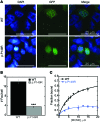Exome sequencing reveals MCM8 mutation underlies ovarian failure and chromosomal instability
- PMID: 25437880
- PMCID: PMC4382257
- DOI: 10.1172/JCI78473
Exome sequencing reveals MCM8 mutation underlies ovarian failure and chromosomal instability
Abstract
Premature ovarian failure (POF) is a genetically and phenotypically heterogeneous disorder that includes individuals with manifestations ranging from primary amenorrhea to loss of menstrual function prior to age 40. POF presents as hypergonadotropic hypogonadism and can be part of a syndrome or occur in isolation. Here, we studied 3 sisters with primary amenorrhea, hypothyroidism, and hypergonadotropic hypogonadism. The sisters were born to parents who are first cousins. SNP analysis and whole-exome sequencing revealed the presence of a pathogenic variant of the minichromosome maintenance 8 gene (MCM8, c.446C>G; p.P149R) located within a region of homozygosity that was present in the affected daughters but not in their unaffected sisters. Because MCM8 participates in homologous recombination and dsDNA break repair, we tested fibroblasts from the affected sisters for hypersensitivity to chromosomal breaks. Compared with fibroblasts from unaffected daughters, chromosomal break repair was deficient in fibroblasts from the affected individuals, likely due to inhibited recruitment of MCM8 p.P149R to sites of DNA damage. Our study identifies an autosomal recessive disorder caused by an MCM8 mutation that manifests with endocrine dysfunction and genomic instability.
Figures



Comment in
-
Reproductive aging and MCM8/9.Oncotarget. 2015 Jun 30;6(18):15750-1. doi: 10.18632/oncotarget.4589. Oncotarget. 2015. PMID: 26119146 Free PMC article. No abstract available.
References
Publication types
MeSH terms
Substances
Grants and funding
LinkOut - more resources
Full Text Sources
Other Literature Sources
Medical
Molecular Biology Databases

